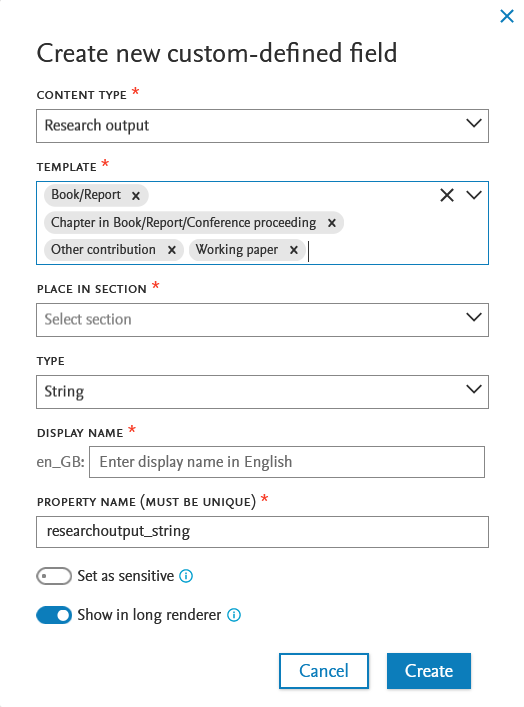How Can We Help?
Custom-defined fields (CDFs)Custom-defined fields (CDFs)
Introduction to CDFs
Custom-defined Fields (CDFs) are an extremely powerful way for your institution to extend your coverage of content without the need to wait for Pure updates. As such, CDFs are created with care and consideration, and your institution (and user) needs and possibilities will be balanced with the limitations and technical considerations associated with CDFs.
Where can CDFs be seen?
After creation, CDF fields are available immediately in the relevant content type editor, reporting and the API. CDFs are NOT visible on the portal.
CDFs are limited to specific content types and formats of fields, listed below:

CDFs can ONLY be added to the following content types and their associated templates:
WarningCDFs will not be supported on the following content types: old project model, PhD Theses, Student Projects, and any Master data content types other than Person and Organization |
CDF fields can take the following formats:
WarningDFs will not be supported for the following formats: lists, datetime and any other data structure not explicitly mentioned above.
|
Additional CDF Limitations
- CDFs cannot be added on relations between content types nor on ancillary data of a content type (anything in a sub-editor or pop-out from an editor).
- CDFs cannot be made mandatory
- CDFs cannot work on conditional parameters i.e. "if a user selects this value, then the CDF should do this."
Sensitive fields
CDFs can be marked as sensitive. Only users who can modify the content can view or edit sensitive CDFs in the content type editor. In reporting and API, only administrators can use sensitive CDFs when creating a report, or when querying/adding content to Pure via the API.
Changing templates
Occasionally, users are required to change templates. Only CDFs configured to exist on both the source and the target template will be migrated. If the same CDF is not present on the target template, the values in the CDF will be copied to the history and comments section of the updated record. If the source CDF is set as sensitive, and target CDF is not set as sensitive, no values will be migrated across, and will not be shown in the history and comments.
Requesting a CDF
How do I request a CDF for my Pure?
Create a case via Product Support Portal, with the following elements:
- Simple title
- Description, including:
- detailed description of your requested CDF
- screenshot of potential location in content type editor
- list of applicable content types (and templates, where relevant)
Acceptance or rejection of request
A CDF will be created in your Pure after careful consideration from our panel of subject matter experts based on the information provided in your request. The panel will consider your institution’s needs, and either:
Suggest an alternative field
or
Accept the request for a CDF (and decide if the suggested CDF should become part of the core data model)
or
Reject the request for a CDF
Info
For each request, detailed reasons for acceptance or rejection will be provided. For accepted requests, a meeting will be scheduled to confirm choices and field names per language. The CDF will be created in a demo (or staging) server and once confirmed by you, will be implemented in your Pure.
Who will create the CDF in my Pure?
CDFs can only be created by Pure staff. This is necessary considering the complications that can arise from an incorrect configuration of a CDF.
Tracking of CDFs
In order to better understand the needs that CDFs address, Pure will track which customers have which CDFs. Any positive trends towards a specific CDF on a specific content type will indicate to us that the field should be included in the core model on that content type.
Viewing, modifying and accessing CDFs
Info
After creation, CDF fields are available almost immediately in the relevant content type editor, reporting and the API. CDFs are NOT visible on the portal
Adding values to a CDF
Currently, values in CDFs can only be added via the editor or via bulk addition in the API (see API documentation Pure API - Custom-defined fields).
Modify CDFs
Only users who can modify content, can modify a CDF.
For example, for a CDF on a research output, contributors can modify or view the fields in the editor once a record has been saved, and if revalidation is enabled.
Rendering of CDFs
CDFs are currently only shown in the metadata tab of a record. CDFs are not displayed in the long render - only with revalidation enabled will a contributor be allowed to view and modify a CDF.
Reporting on CDFs
For non-sensitive CDFs, users with reporting permissions are able to use CDFs in reporting, and only for the content types for which they have reporting permissions. For sensitive CDFs, the reporting user must also have editing permissions before they can report on the CDFs.
Accessing CDFs via the API
Read and write access to CDFs are defined by user and API key rights. For full documentation on read and write access, please consult the API documentation Pure API - Custom-defined fields
Published at December 14, 2023
